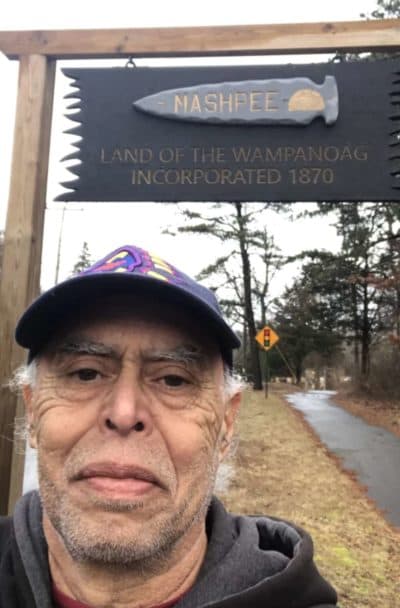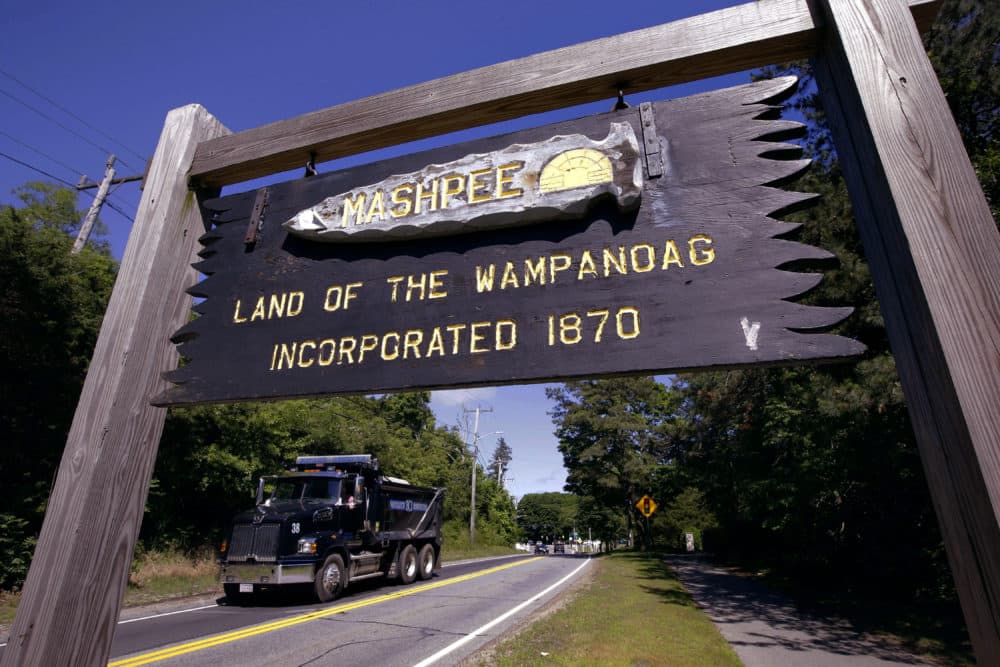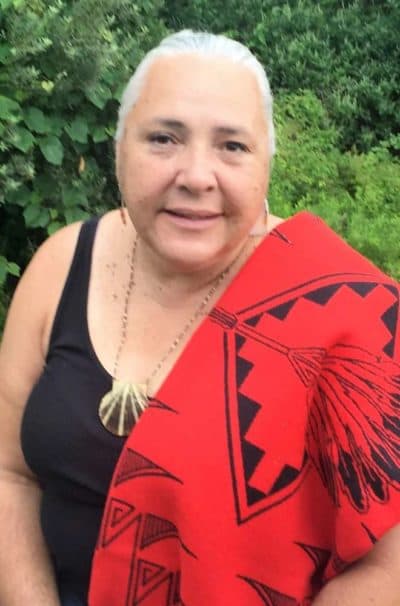Advertisement
'Bone dust in my skin': How a legacy of racism has left nearly 117,000 native ancestors not at rest
For centuries, archeologists and amateur collectors looted Native American graves in Massachusetts and across the country, taking the remains of people — and the objects that were buried with them. Sometimes farmers or developers unearthed people unintentionally. They were given to museums, universities and even libraries.
Institutions have reported to the government they have the remains of nearly 117,000 people.
That includes about 60 who were dug up in central and western Massachusetts. It's taking a long time to get them home.
'It’s A Responsibility To Carry That On'

When Jim Peters was growing up on Cape Cod decades ago, the local sheriff contacted his father, a Mashpee police officer and tribal leader known as “Slow Turtle.” The sheriff had made a discovery.
"He was finding native remains in different town halls and libraries and other places. And they started going through the process of reburying them. He would come and drag me along, say, 'I got something for you to do!’ And that started our process of reburying our ancestors," Peters recalled.
Peters said native burial sites often had an ocean view, the same places where people wanted to build houses.
“As Cape Cod began to develop," he said, "our people got displaced more or more, and then no one knew what to do with them or even cared. So they found themselves in different closets and things like that, basements or whatever.”
Peters is a member of the Mashpee Wampanoag Tribe and executive director of the Massachusetts Commission on Indian Affairs. He said he has helped rebury hundreds of people. The experience has changed him.
"Once I had that bone dust in my skin, it’s something that stuck with me ever since. It’s made an impact on my life," Peters said. "It’s a responsibility to carry that on."
He said it’s important to take his ancestors out of adverse settings and return them to the earth.
Bettina Washington, the cultural director of the Wampanoag Tribe of Gay Head (Aquinnah), said reburying is not easy.
“It takes a lot out of you. You need to be well prepared for it. And you need to take care of yourself, before and after," Washington said. "And, at the same time, it's gratifying, to make sure your ancestors are now safe.”
There are many more native ancestors who are still today in museums and schools. When looters dug them up, they were seen as specimens, not as human beings. Or they were viewed as objects of racist scientific research — now debunked — that purported to look at innate differences between peoples.
'Oftentimes, Museums Will Make It Very Difficult'
The Stockbridge-Munsee Community Band of Mohican Indians is also focused on getting ancestors back. For historic preservation manager Bonney Hartley, it’s a spiritual obligation.
"So many people, all these ancestors are not at rest," Hartley said in an interview recorded in the fall of 2020. "They’re on these shelves and the road to be able to bring them home can sometimes be incredibly, painfully long."
Long, in part, because of the NAGPRA process. That’s the 1990 Native American Graves Protection and Repatriation Act, designed to let tribal nations know where their ancestors are, and to provide a process for bringing them home. It applies to institutions that receive federal funding.
Hartley said when she first started, she expected it would be much easier.
"Oftentimes, museums will make it very difficult and you have to go like fragment by fragment of someone’s body and make the case for why you know that that is directly, culturally affiliated with your nation," Hartley said. "And if they’re from a long time ago, thousands of years back, then it’s hard to satisfy their criteria sometimes."
When a museum lists an individual as culturally not affiliated to any tribe, it can stop or slow down the return of ancestors to their people. Sometimes museums don’t have much documentation with remains.
The Berkshire Museum in Pittsfield has possession of small bone fragments — the remains of at least two native people, according to Jason Vivori, collections experience manager at the museum. They were donated to the museum probably more than 100 years ago, and are secured in boxes away from the public and staff.
“The notes with them, and these are just little tiny pieces of paper, just list where they were located from Springfield," Vivori said. "They mention the person who collected them. And they were essentially river washout from an Indian burial ground, is what it says on the label.”
With so little to go on, in the 1990s as part of the NAGPRA process, the museum determined it wasn’t clear which tribe they belonged to.
"But now we're looking at it and going, ‘No, these clearly belong ... we know where they came from. Now it's just a matter of determining what community they belong to, or if we can't determine which community, which community is willing to handle affiliating them so that they can take them and rebury them," Vivori said. "Because otherwise they just end up doing the same thing they're doing now, just sitting on a shelf."
Although it’s taken decades, the Berkshire Museum is beginning to organize a consultation with tribes, something the law requires. Vivori said what tribal members have to say is most important.
“To make sure they're the ones who are really determining what is or isn’t theirs," Vivori said. "At one point in time, there was much more of a focus that the museum was the final decision on that sort of thing. That’s not so now and certainly not our viewpoint.”
Vivori won’t name the tribes the museum is consulting with, out of respect for their privacy.
'Who Are You To Tell Us Whether We Were Here Or Not?'
Despite the shift to more collaborative thinking at museums like this, the NAGPRA law does put museums in charge of determining affiliation, after consulting with tribes.
And it doesn’t always go smoothly, as Jim Peters knows. About ten years ago, his tribe, the Mashpee Wampanoag, had to prove to a museum that the remains of people dug up in Cotuit on Cape Cod, belonged to the tribe.

"But they said that they weren’t culturally affiliated with us because they were over 1,000 years old and that there was a question of whether we were here at that time and so forth. And we got a little upset about that," Peters said. "‘Who are you to tell us whether we were here or not?’"
He pointed out that his people were here to greet the Pilgrims and long before that.
NAGPRA allows for several types of evidence of affiliation including geographical, historical and some types of indigenous knowledge.
“We have village sites in Cotuit that we know of and we know the history of them taking Cotuit from us," said Peters. "They didn't have a strong enough argument to go against us.”
Peters declined to name the museum. He still has to work with them.
Peters said when NAGPRA was first enacted, it was more contentious with museums. He said things are better now, in part because of the way archeologists have been trained about the ancestors.
“Before they were just subjects and there was no connection to them at all or any respect for them," Peters said. "And that's changed.”
The National Park Service, which administers NAGPRA, has an inventory of human remains still at institutions in the U.S. It includes about 60 people who had been dug up in western and central Massachusetts and are now located in six museums. NEPM contacted all of them.
Each started the NAGPRA process after it became law in 1990, but typically because of staffing, funding and knowledge about the remains, the process stopped or stalled. All of the individuals are listed as “not culturally affiliated,” meaning the institutions haven’t established which present-day tribe they’re affiliated with. That’s the case for seven individuals at the Yale Peabody Museum of Natural History.
"Because of that determination, the consultation process tends to move a little more slowly as making a cultural affiliation to a particular tribe, while a priority, is often not possible," said Jessie Cohen, Yale Peabody's repatriation compliance coordinator.
Cohen said the seven were dug up from two locations in Turners Falls in the early 1900s by amateur archeologists.
Under the law there, may not be a tribe associated with Turner’s Falls, but Nipmuc, Wampanoag, Narragansett, Wabanaki and Pocumtuck communities fished for shad and salmon there. And Captain William Turner, for whom the falls are named, attacked native people near the falls during King Philip’s war.
But Cohen said, according to the law at least, there is no federally recognized tribe that is “aboriginal” to Turners Falls.
"That's a tribe that was specific to the area in which these remains came. And there isn't one for this particular location," Cohen said. "So we don't immediately have a tribe or list of tribes to go to, and that's when we start to take that regional approach."
That means the museum will invite a group of tribes from the region to consult to determine what will happen to the remains. Cohen doesn’t know yet when that process will begin for the Turners Falls remains. Yale Peabody said it has repatriated 500 of the 1100 ancestors it once had, and is working on repatriating the remains of another 600 individuals from across the country.
The Tribes 'Work Together To Repatriate'

Bettina Washington of the Aquinnah Wampanoag said a regional approach is a good move toward resolution. She said her tribe, although based on Martha’s Vineyard, is culturally affiliated to the entire New England area, including western Massachusetts.
“We intermarried. We traveled. We didn't just stay in our little areas," Washington said. "So it could be that the person belonged to one of the multitude of tribes or could be a tribe that no longer has a lot of representatives. We work together to repatriate.”
The Peabody Museum of Archaeology and Ethnology at Harvard University, Warren Anatomical Museum at the Harvard Medical School, Springfield Science Museum and Worcester Historical Museum still have the remains of individuals dug up in Worcester, Franklin, Hampshire and Hampden counties, according to the NAGPRA inventory.
The Springfield Science Museum, according to the federal database, has 25 individuals from Worcester County. The museum said it doesn’t know if that’s accurate, but is working with native consultants to figure it out.
The Worcester Historical Museum confirmed it has the remains of one person from Worcester County. After NEPM contacted the museum, it said staff are now "actively working" to take the next steps in the repatriation process.
One institution that was once on NAGPRA’s inventory is Mount Holyoke College. The remains of a native woman were donated to the school in January 1918 by a Holyoke couple.
"Dear Prof. Turner, It gives us great pleasure to present to you as the custodian of the Physiological Dept. of Mt. Holyoke College the accompanying bones and specimens,” read a letter from the couple.
Aaron Miller, the NAGPRA coordinator at the Mount Holyoke College Art Museum, said the college began to re-examine its compliance with NAGPRA in 2014.
“The conversation came up that there had been remains on campus, but at that time we believed they had been part of a larger repatriation, that was really coordinated by UMass Amherst," Miller said.
In 2014, the University of Massachusetts repatriated 96 individuals from western Massachusetts, some of whom had been transferred to UMass from Smith and Amherst colleges.
But the individual was still on Mount Holyoke's campus.
Starting in 2015, the school consulted with six tribal nations. The remains were moved from the main campus to a small building down the road at the college’s Joseph Allen Skinner Museum.
Inside the building, there's a small room with an empty table. At one point, there was a wooden box here that cradled the remains of the native person.
“This was the secure room in the back here," Miller said on a recent visit. "It was not a space where anyone had any reason to go and we were trying to be as respectful as possible and make sure the remains were in an appropriate place while the process [of repatriation] was going on.”
As part of the process, between 2015 and 2020, Mount Holyoke consulted with the Stockbridge-Munsee Community, the Wampanoag Tribe of Gay Head (Aquinnah), the Abenaki Nation of New Hampshire, Cowasuck Band of the Pennacook-Abenaki People, Elnu Abenaki Tribe and the Webster/Dudley Band of the Chaubunagungamaug Nipmuc Indians.
In October 2021, with campus police assisting, the ancestor was moved out of the building and brought to the Nipmuc Nation for reburial.
It was a long road home. Hundreds of years long.
This story is part of the New England News Collaborative. It was originally published by New England Public Media.